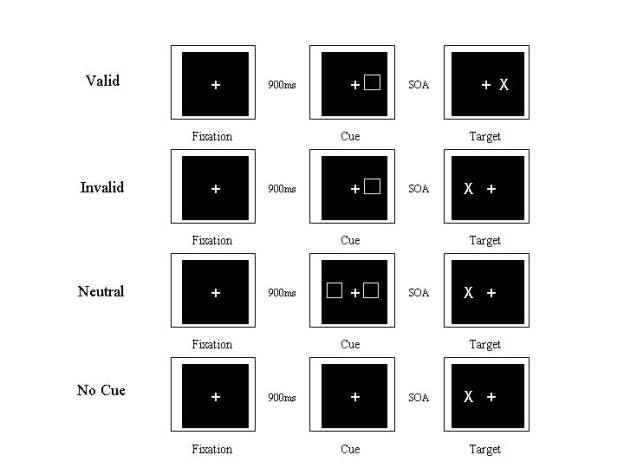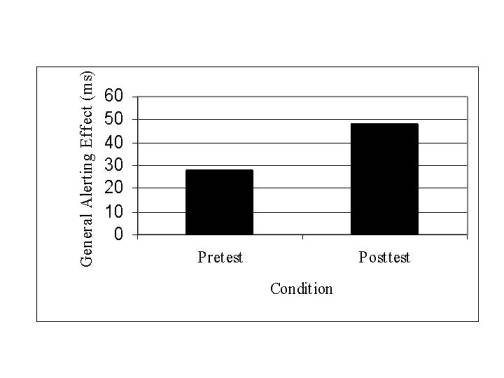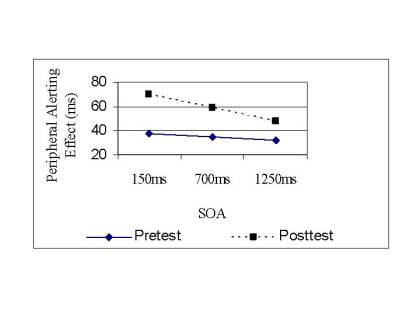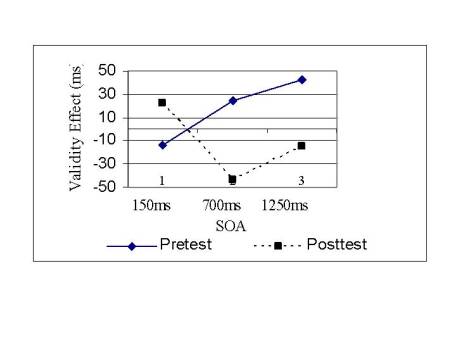Pilot Study: The Effects of Video Gaming On Visual Orienting and Vigilance
Melissa J. Jenks
Kelly LeTarte
Raymond D. Collings*
State University of New York College at Cortland
Abstract
The current study piloted an intensive computer gaming intervention designed to improve visual orienting and vigilance with a normative sample of seven undergraduates. Seven undergraduates participated in a 6-week intervention study, involving 90-minute daily gaming sessions. Pretest/posttest differences in VOT performance revealed that the 6-week intervention’s effects on both measures of attention (visual orienting and vigilance) were found to be large, albeit non-significant. Following the intervention, participants appeared to become more alert following cue presentations, and this alerting effect appeared to occur more rapidly than prior to the intervention. A smaller improvement in the ability to shift attention was also observed post-intervention. These findings provide preliminary evidence that such an intervention might benefit some individuals with related attention deficits.
Pilot Study: The Effects of Video Gaming On Visual Orienting and Vigilance
Treatment for Attention Deficit Hyperactivity Disorder (ADHD) has generally been focused on pharmacological approaches. Based on empirical findings from the stroke rehabilitation and dyslexia reading-intervention literature, there is some reason to believe that intensive behavioral interventions might provide sufficient experience to promote the development of more adaptive neural attention systems. In a larger study, we are interested in discovering whether the remediation of attention-related deficits found among individuals could be accomplished through non-pharmacological interventions. The current pilot study was aimed at examining the practicability of using such an intervention to affect specific attention processes among a normative sample of undergraduate students.
Some authors have linked the attention problems among individuals with Attention Deficit Hyperactivity Disorder-Combined Type (ADHD-C) and Attention Deficit Hyperactivity Disorder-Hyperactive Impulsive Type (ADHD-HI) with inhibitory processes involving the frontal and prefrontal areas of the brain (Barkley, 1997, Quay, 1997). Rather than having existing deficits related to the neural systems involved in vigilance and selective attention, these researchers believe that failures in the behavioral inhibition system prevent the individual from sustaining attention (Barkley, 1997, Quay, 1997). Although the Attention Deficit Hyperactivity Disorder-Inattentive Type (ADHD-IA) is largely identified by the same realm of inattention problems, arguments have been presented that this ADHD population’s deficits are different from those associated with the ADHD-C group. One such perspective links the ADHD-IA symptoms with visual orienting deficits, apparently due to problems with the posterior orienting system which has been associated with disengaging and shifting the attention system from one spatial location to another ( Collings & Kwasman, 1996; Fisher, 1998; Voeller & Heilman, 1988). On the other hand, ADHD-IA Type symptoms may stem from deficits in the vigilance system, resulting in an inability to become and remain alert for impending information (Posner & Raichle, 1994). In an exploratory study involving children who met the diagnostic criteria for either ADHD-IA or ADHD-C Types, researchers found that the ADHD-IA participants had difficulty responding to targets in the periphery but only when they were required to remain alert for the impending target for more than one second (Collings & Kwasman, 1996). This was not found to be true of the ADHD-C or non-ADHD control participants. Those findings would suggest that any behavioral intervention that provides significant remediation for visual orienting and vigilance processes might be especially beneficial to individuals with the ADHD-IA Type. However, it would be helpful to first establish that such an intervention impacts these processes among a normative sample of individuals.
Posner’s Visual Orienting Task (VOT; Posner & Cohen, 1984) has been widely used to examine processes related to visual orienting. In this paradigm, a cue is presented to the right or left side of the screen. This cue automatically draws the attention to that area. A target appears either there, or on the opposite side of the screen. If it appears in the cued location responses are typically fast, because the person’s attention is already there. If the target appears on the opposite side of the display, then the person must shift attention to that location, slowing the response. Validity effect is the variation in reaction time (RT) to targets appearing in the cued location (valid cue) and the non-cued location (invalid cue). This is a simple measurement of how much time it takes to shift attention. Inhibition of Return (IOR), emerging at about 400-500 ms, is an effect that temporarily keeps an individual from shifting attention back to a previously attended location.
In a series of Visual Orienting Task (VOT) studies concerning non-ADHD adults, two distinct alerting processes were identified (Collings & McClarren, under review). The first one, the General Alerting Effect, emerges immediately after the cue is presented and increases alertness for any incoming target, regardless of its eventual location. This General Alerting Effect is measured by finding the difference between reaction time (RT) between the no cue condition and the neutral cue condition. This effect speeds up RT by making participants more alert and vigilant. The second alerting affect, the Peripheral Alerting Effect, emerges only after several hundred milliseconds and facilitates response to targets appearing in the periphery (Collings & McClarren, under review). The Peripheral Alerting Effect speeds up responses to targets in the periphery when the cue is presented approximately 700-1000 ms prior to the target. Because vigilance has been associated with noradrenergic pathways in the brain ( Clark, Geffen, & Geffen, 1989; Coull, Nobre, & Frith, 2001 ), it has been suggested that maladaptive noradrenergic pathways may obstruct the ability to become alert for stimuli that might appear in the periphery among some individuals with ADHD (Posner & Raichle, 1994). Such maladaptive pathways may underlie the apparent alerting deficits among at least some individuals with ADHD-IA type. Although stimulant medications may promote the modulate levels of norepinephrine, temporarily relieving related attention problems, there is no evidence that such pharmacological interventions offer long-term remediation for individuals with ADHD.
However, recent research in the area of brain (neural) plasticity suggested that the brain has the ability to reconfigure itself (Holloway, 2003; Taub & Uswatte, 2003). These studies support the idea that the brain can be broadly remodeled throughout the course of one’s life, without drugs or surgery. Clinical studies in the field of stroke rehabilitation and speech development for children with dyslexia show that even through late adulthood the brain has the ability to form new and more adaptive networks using a series of intense mental and physical exercises (Eden et al., 2004; Merzenich, Wright, Jenkins, 2002). Therapies being developed in collaboration with this new research essentially involve a program of scrupulous daily activities in which the individual is required to make use of impaired abilities, thereby stimulating the brain to develop more adaptive networks.
We suspect that a similar approach, involving an intensive program of visual orienting tasks might be an effective means of promoting improvements in these skills. To this end, we have proposed an experimental 6-week regiment of daily activities consisting of computer games. These games would all involve frequent shifts in attention. In the current pilot study, we administered the proposed intervention to a small normative sample of undergraduate students. Using pretest and posttest administrations of Posner's VOT, we looked for improvements in both visual orienting and vigilance. We hypothesized that we could increase orienting, general alerting affect, and periphery alerting effect using an intensive gaming intervention. In addition, we predicted that we would be able to increase the validity effect through this intervention method.
Methods
Participants
Seven participants (2 males and 5 females), with a mean age of 19.71 (SD = .756), participated in this study as part of a psychology research course. Although they received course credit in exchange for their participation, they were given the alternative of withdrawing from the study at anytime, either by assuming other research activities (i.e., data entry, literature reviews, etc), or by withdrawing from the course without consequence. This issue was important because attrition was a crucial concern, given the nature of the rigorous intervention. Interestingly, no participants dropped out of the study, although it should be noted that these were non-ADHD and highly-motivated participants.
Instruments
The pretests consisted of the Current Symptom Scale (CSS; Barkley & Murphey, 1998), Edinburgh Handedness Inventory (EHI; Oldfield, 1971), Wonderlick Personnel Test (WPT; Wonderlic Personnel Test Inc., 1998), and a Health History Questionnaire (HHQ: see Collings & McClarren, under review). Additionally, a visual acuity screening was done to establish if any participants had visual impairments that might hinder their ability to perform the visual orienting task. All participants scored in the normal range on all assessments, with a no participants reporting prior diagnoses of ADHD or learning disabilities. When the score on the WPT was converted to a WAIS equivalent score, the mean IQ for the sample was 109, (SD = 3.705). All the participants were right-handed.
Visual Orienting Task: (Figure 1.) A short version of the Posner’s exogenous Visual Orienting Task (VOT; Posner & Cohen, 1984) was administered during each of the pretest and posttest assessments. In our paradigm, a cue (highlighted box) originally directed the participant’s covert attention to one visual field (right or left), followed by a target (letter “x”) appearing either in the cued position (valid cue condition) or in non-cued condition (invalid cue condition). The participant responded to the target via a keystroke, with reaction time (RT) serving as a dependent variable (DV). The cue induced an automatic shift in attention to its location, generally facilitating responses to targets consequently appearing at that location (valid condition) and slowing responses to targets appearing in the opposite visual field (invalid condition). Two additional cue conditions were included: a neutral cue (cue boxes appearing in both visual friends concurrently) and a no cue condition. The lag between the cue and target, referred to as the stimulus onset asynchronicity (SOA) was also varied (150msm 700ms, and 1250 ms). The task involved 128 trials, with 30% valid, 30% invalid, 30% neutral, and 10% no cue conditions.
Figure 1. Four Validity Conditions Of Visual Orienting Task
Results and Discussion
A series of repeated-measures Analyses of Variance were used to test each of our hypotheses. Given our small sample size, we did not expect main effects or interactions to be statistically significant at conventional levels ( a=.05). Instead we focused on the effect size indicators ( h), although all relevant statistics were reported.
In terms of the general alerting effect the proportion of variance attributed to the intervention was not significant, although the effect size was large, F(1,6)= 3.13, p<.127, η=.59. Figure 2 depicts the mean general alerting affect, which was obtained by subtracting the reaction time in the neutral cue condition from the reaction time in the no cue condition.
Figure 2. Mean General Alerting Effects
Mean General Alerting Effect (RT no cue – RT neutral cue). Pretest SD = 44.023 Posttest SD = 65.071.
Our second hypothesis proposed that the peripheral alerting effect would also be altered by our intervention. Again, the effect for intervention was large, albeit non-significant, F (1,6) = 1.773, p<.231, η= 48. As Figure 3 reflects, the mean peripheral alerting affect was also increased through the video gaming intervention. The moderately large, but non-significant interaction between the SOA and intervention on the peripheral alerting effect suggested that the gaming intervention impacted the peripheral alerting affect across the time intervals. However, the impact was greatest immediately after the cue was presented and decreased after 700 and 1250 ms., F(1,6)= 1.711, p<.222, η=.47.
Figure 3. Mean Peripheral Alerting Effects
Mean Peripheral Alerting Effect (RTno cue – RTinvalid cue-General Alerting Effect). Contact authors for SDs.
We also hypothesized that through this intervention method we could increase the validity effect. This ability to shift does appear to be affected, but it is dependent on the SOA, reflected in the marginally significant and large intervention by SOA interaction, F(1,6)=.321, p<.089, η=.57 (see Figure 4).
Figure 4. Mean Validity Effects
Mean Validity Effect (RTinvalid - RTvalid). Contact authors for SDs.
Despite the small sample size and design limitations (i.e., no control condition), these preliminary findings do provide evidence that our gaming intervention did result in improvements in visual orienting and vigilance. Some convergent validity for this inference was provided by preliminary analyses of pre and posttest electroencephalogram (EEG) recordings of the same individuals (Withers, Creager, & Collings, 2007). Those findings indicated a post-intervention increase in alpha activity during resting conditions—activity that has been associated with heightened states of alertness (Clarke, Barry, McCarthy, Selikowitz, & Brown, 2002). A post-intervention decrease in alpha activity during alerting conditions was also observed. If, as Posner and Petersen (1990) argued, such activity is reduced by stimulus-related (phasic) alertness, this finding would suggest that the gaming intervention facilitated increased arousal by the cue presentation. Taken together, the current behavioral data and the EEG findings would suggest that our intervention had a noticeable effect on participants’ ability to become vigilant for stimuli appearing in the periphery. Although these current data are clearly preliminary in scope, they should serve as a foundation for subsequent confirmatory studies, and for studies examining the efficacy of such interventions involving individuals with ADHD.
References
Barkley, R. A. (1997). Attention-deficit/hyperactivity disorder, self-regulation, and time: Toward a more comprehensive theory. Journal of Developmental & Behavioral Pediatrics, 18, 271-279.
Barkley, R. A., & Murphy, K. R. (1998). Attention-Deficit Hyperactivity Disorder: A Clinical Workbook (2nd ed.) . New York: Guilford Press.
Clarke, A.R., Barry, R.J., McCarthy, R., Selikowitz, M., & Brown, C.R. (2002). EEG evidence for a new conceptualization of attention deficit hyperactive disorder. Clinical Neurophysiology, 113, 1036-1044.
Clark, C. R., Geffen, G. M., & Geffen, L. B. (1989). Catecholamines and the covert orientation of attention in humans. Neuropsychologia, 27(2), 131-139.
Collings, R. D., & Kwasman, A. (2006). Visual orienting deficits among ADHD-Inattentive Type children. Individual Differences Research, 4, 111-122..
Collings, R. D., & *McClarren, S. (manuscript under review). Spatial and Alerting Effects in the VOT: Beyond the Spotlight.
Coull, J. T., Nobre, A. C., & Frith, C. D. (2001). The noradrenergic α2 agonist clonidine modulates behavioural and neuroanatomical correlates of human attentional orienting and alerting. Oxford University Press, 11 (1), 73-84.
Eden, G. F., Jones, K. M., Cappell, K., Gareau, L., Wood, F. B., Zeffiro, T. A., Dietz, N. A.E., Agnew, J. A., & Flowers, (2004). D. L. Neural Changes following Remediation in Adult Developmental Dyslexia. Neuron, 44, 411-422,
Fisher, B. C. (1998). Evaluation of Attention Deficit Disorder. Attention Deficit Disorder Misdiagnosis: Approaching ADD from a brain-behavior/neuropsychological perspective for assessment and treatment. Boca Raton, Fl: CRC Press, pp. 271-293.
Holloway, M. (2003). The Mutable Brain. Scientific American, 79-85.
Merzenich, M. M., Wright, B. A., & Jenkins, W. (2002). Cortical plasticity underlying perceptual, motor, and cognitive skill development: Implications for neurorehabilitation. In M. H. Johnson, Y. Munakata, & R. O. Gilmore (Eds.). Brain Development and Cognition: A Reader (2nd ed., pp. 292-304). Malden, MA: Blackwell Publishing.
Oldfield, R. C. (1971). The assessment and analysis of handedness: The Edinburgh Inventory.Neuropsychologia 9(1), 97-113.
Posner, M.I., & Cohen, Y.A. (1984). Components of Visual Orienting. In: H. Bouma & D.G. Bouwhuis (Eds), Attention and Performance X. (pp.531-554), Hillsdale NJ. Lawrence Erlbaum and Associates.
Posner, M. I., & Petersen, S. E. (1990). The attention system of the human brain. Annual Review of Neuroscience, 13, 25-42.
Posner, M. I., & Raichle, M. E. (1994). Networks of attention. Images of Mind, New York : Scientific American Library, pp. 153-180.
Quay, H. C. (1997). Inhibition and Attention-Deficit/Hyperactivity Disorder. Journal of Abnormal Child Psychology, 25, 7-13.
Taub, E. & Uswatte, G. (2003). Constraint-induced movement therapy: bridging from the primate laboratory to the stroke rehabilitation laboratory. Journal of Rehabilitation Medicine, 35, 34 – 40.
Voeller, K. K., & Heilman, K. M. (1988). Attention deficit disorder in children: A neglect syndrome?Neurology, 38(5), 806-808.
Withers, B., *Creager, W. R., & Collings, R. D. (manuscript under review). Pilot Study: The Effect of Video Gaming On Attention-Related EEG Activity. Undergraduate Research Journal for the Human Sciences, 6, retrieved from /urc/urc_research_journal6.html.
Wonderlick, C. F. (1988). Wonderlic Personnel Test. Libertyville, IL: Wonderlic Personnel Test, Inc.
Authors’ Note
Funding for the current study was provided by a Faculty Research Grant through the Research Foundation at the State University of New York College at Cortland (Raymond D. Collings, Principal Investigator). The authors would like to acknowledge the following student research assistants for their help with the project: Suzanne Karp, Victoria Puzo, Kaitlyn Murphy, Bryant Withers, Ivano Iaia, Troy Lichten, Whitney Creager, Anthony Nelson, Diella Giaconia, Andrew Drago, Peter Scialdone, Miranda Hendrickson, Adrianne Fuller, Merlann Pena, Emily Raynor, and Elizabeth Sinclair. Portions of the data presented here were presented at the 2006 annual conference for the Eastern Psychological Association in Baltimore.
|



